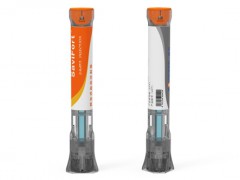????通訊員 據(jù)今日油價(jià)3月2日?qǐng)?bào)道,“地?zé)崾辍边@句話在媒體和能源行業(yè)的聚會(huì)上越來(lái)越常見(jiàn),因?yàn)閲?guó)際凈零排放計(jì)劃包括了從地球上提取能源的最吸引人和最清潔的方式之一:地?zé)岚l(fā)電。
????為了達(dá)到地球地幔輻射到地核的熱量,地?zé)峁拘枰@探——而且需要鉆得很深。事實(shí)上,這個(gè)新興行業(yè)面臨的最大挑戰(zhàn)之一是鉆到足夠深的地方,以達(dá)到真正的高溫。但是,鉆這么深是有風(fēng)險(xiǎn)的,也是昂貴的。
????然而有報(bào)道稱,地?zé)峒词乖诟〉纳疃纫材馨l(fā)揮相當(dāng)大的作用。根據(jù)Rystad Energy最近的一項(xiàng)分析,要從地?zé)峋屑訜岬钠邪l(fā)電,發(fā)電設(shè)施需要240至300攝氏度的溫度。該分析還指出,目前多達(dá)70%的地?zé)岙a(chǎn)出用于發(fā)電。
????事實(shí)上,無(wú)論明智與否,人們都渴望讓一切都電氣化,這一切都與電有關(guān),更具體地說(shuō),是無(wú)排放的電。地?zé)岱浅_m合這樣做:雖然地?zé)峋你@探確實(shí)涉及使用化石燃料的設(shè)備,但從壽命的角度來(lái)看,地?zé)崤c風(fēng)能和太陽(yáng)能完全可比,考慮到它們需要的材料,風(fēng)能和太陽(yáng)能也并非完全無(wú)排放。
????然而,由于高昂的前期成本和對(duì)鉆探結(jié)果的普遍不確定性,地?zé)崮馨l(fā)展緩慢。行業(yè)專家總是注意到,我們腳下到處都是“熱能”,但他們也強(qiáng)調(diào),并不是所有的“地?zé)帷倍寄敲慈菀祝蛘哒f(shuō)可以以非常經(jīng)濟(jì)的方式達(dá)到。冰島一直是一個(gè)很好的例子,因?yàn)樗牡責(zé)豳Y源很容易獲取,還有意大利和土耳其。
????難怪地?zé)犷I(lǐng)域的大量工作都集中在使更深層鉆探更經(jīng)濟(jì)的技術(shù)上。大型石油公司的加入對(duì)石油行業(yè)來(lái)說(shuō)是件好事。畢竟,這些公司進(jìn)入地?zé)犷I(lǐng)域最有意義,因?yàn)樗麄冏盍私忏@探技術(shù)。
????說(shuō)到石油,一些公司一直在研究和測(cè)試一些東西,可以擴(kuò)大地?zé)崮艿姆秶故凸臼芤妗獙U棄的油井變成地?zé)崮芫?/p>
????有一些公司正在朝著這個(gè)方向努力,要么把廢棄的油井變成地?zé)峋醋屗鼈兂蔀榧饶墚a(chǎn)生熱量又能產(chǎn)生石油的兩用井。從理論上講,將油井改造為地?zé)峋畬?duì)促進(jìn)地?zé)岬钠占坝泻艽蟮膸椭H欢瑢?shí)際上,這并不是那么簡(jiǎn)單。
????德克薩斯大學(xué)奧斯丁分校地?zé)釀?chuàng)業(yè)組織的Jamie Beard表示,首先,這類井的流量遠(yuǎn)低于新鉆的地?zé)峋F浯危诎l(fā)電方面,大多數(shù)油井的溫度根本不足以產(chǎn)生經(jīng)濟(jì)意義。第三,Beard表示:“現(xiàn)有的油井經(jīng)常遭受油井完整性問(wèn)題的困擾,這將使它們不適合作為一種生產(chǎn)地?zé)豳Y產(chǎn)使用20-40年。”
????好消息是,這并不意味著把廢棄井變成熱能利用井是完全不可能的。記住,發(fā)電是地?zé)徙@探的主要目的,但供暖作為一個(gè)應(yīng)用領(lǐng)域也不應(yīng)被低估。
????一些公司利用廢棄的井注入水,加熱,然后用來(lái)取暖。如果油井選擇正確,發(fā)電也不是不可能的。然而,廢棄的水井似乎更適合供暖。
????英國(guó)律師事務(wù)所Fieldfisher油氣業(yè)務(wù)主管保羅?斯托克利(Paul Stockley)表示,即便是在這個(gè)領(lǐng)域,也存在挑戰(zhàn)。其中一個(gè)問(wèn)題是,水需要在井中停留多長(zhǎng)時(shí)間才能變得足夠熱。此外,成本也應(yīng)該要注意。
????廢棄的井似乎最適合作為附近建筑物和設(shè)施的熱源。斯托克利指出,可以用于農(nóng)業(yè)作業(yè)。因?yàn)樵谟?guó),大多數(shù)陸上油井都在農(nóng)田附近,所以這種匹配幾乎是完美的。
????因此,并不是所有的廢棄油井都適合轉(zhuǎn)化為地?zé)醿?chǔ)層。然而,一些人可能會(huì)獲得二次利用機(jī)會(huì),然后可以用來(lái)加熱附近的設(shè)施。總的來(lái)說(shuō),對(duì)于發(fā)電來(lái)說(shuō),新的鉆探似乎是目前更好的選擇。而且,與其他任何技術(shù)一樣,成本必將繼續(xù)下降,特別是在大型石油投資的幫助下。甚至還出現(xiàn)了利用地球地?zé)豳Y源的新研究領(lǐng)域:廢棄煤礦的利用。
????王佳晶 摘譯自 今日油價(jià)
????原文如下:
????Can Abandoned Oil Wells Be Used To Generate Geothermal Power?
????“The decade of geothermal” is a phrase that is becoming increasingly common in media and energy industry gatherings as the international zero-emission push comes to include one of the most fascinating—and clean—ways of extracting energy from the earth: geothermal power.
????To reach the heat that the mantle of the Earth radiates into the core, geothermal companies need to drill—and they need to drill deep. In fact, one of the biggest challenges for this emerging industry is drilling deep enough to get to the really high temperatures: drilling so deep is risky and costly.
????Yet geothermal can do pretty well even at smaller depths. According to a recent analysis by Rystad Energy, to generate electricity from the vaporized water heated up in geothermal wells, a power generation facility needs temperatures of 240 to 300 degrees Celsius. The analysis adds that as much as 70 percent of geothermal output right now is used for electricity generation.
????Indeed, with the urge to electrify everything—whether this is wise or not—it’s all about electricity and, more specifically, emission-free electricity. Geothermal is perfect for this: while the drilling of a geothermal well does involve equipment that uses fossil fuels, from a lifetime perspective, geothermal is fully comparable with wind and solar, which are also not entirely emission-free given the materials they need to operate.
????Yet geothermal has been slow to take off because of the high upfront costs and the general uncertainly about the result of drilling. Industry experts invariably note that the heat is everywhere beneath us, but they also make a point of emphasizing that not all of that heat is that easy—or economical—to reach. Iceland is always a case in point with its easily reachable geothermal resources, as well as Italy and Turkey.
????No wonder then that a lot of effort in geothermal has focused on the technology to make deeper drilling economical. It’s been a boon for the industry that Big Oil has joined the party. After all, these are the companies whose entry into geothermal makes the most sense, given they know drilling best.
????Speaking about oil, some companies have been researching and testing something that could expand geothermal’s reach and benefit oil companies: turning abandoned oil wells into geothermal wells.
????There are a few companies working in this direction, either turning abandoned wells into geothermal ones or making them double-use wells that yield both heat and oil. Theoretically, the transformation of oil wells into geothermal wells can be of great help for boosting geothermal’s popularity. Practically, however, it’s not that straightforward.
????For starters, flow rates from such wells are much lower than from newly drilled geothermal wells, Jamie Beard from the Geothermal Entrepreneurship Organization at the University of Texas at Austin told Oilprice. Then there is the issue of heat: most oil wells are simply not hot enough to make economic sense if we are talking about electricity generation. Thirdly, Beard says, “existing wells often suffer from well integrity issues that will make them ill-suited for a 20-40 year lifespan as a producing geothermal asset.”
????The good news is this does not mean turning abandoned wells into heat-producing reservoirs is completely off the table. Remember, electricity generation is the main purpose of geothermal drilling but heating should not be underestimated as an area of application, either.
????Some companies are using abandoned wells to inject water into them, heat it, and use it for, well, heating. Power generation is also not out of the question if the well is right. Yet it seems that abandoned wells are better suited for heating purposes.
????Even in that area, however, there are challenges, says Paul Stockley, head of Oil and Gas at UK-based law firm Fieldfisher. One of these is how long the water needs to stay in the well to become hot enough to be used for heating. The longer the time, the lower the viability of the system. Costs should also be borne in mind, Stockley notes. Even if drilling costs are taken out of the equation, there is injection equipment and transfer-of-heat equipment to consider.
????It appears that abandoned wells are most viable as a heating source for nearby buildings and installations. For instance, Fieldfisher’s Stockley notes agricultural operations that can be heated. Since in the UK most onshore oil wells are near farmland, the match is almost perfect.
????Not all abandoned oil wells, then, are suitable for converting into geothermal reservoirs. Some may, however, get a second life to heat up water that could then be used to heat a nearby facility. For electricity generation, new drilling appears to be the better option for the time being, overall. And, as with any other technology, costs are bound to continue falling, especially with the help of Big Oil investment. There are even new areas of research into harnessing the geothermal resources of the planet: flooding abandoned coal mines and using the water heated in this way to generate electricity and use it for heating and cooling.







